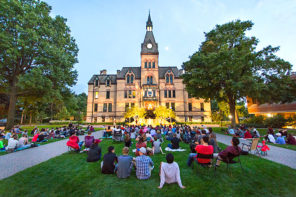In 1970, at the age of four, I left Pakistan and came to Canada with my parents. At that time, there were less than 34,000 Muslims in all of Canada. By 2001, this number had grown to 579,600. While the population of Muslims grew tremendously in North America, we were almost absent from the array of characters portrayed on television. When I was a child, Hadji from reruns of the animated show Johnny Quest, was the only Muslim I could identify on television, with the added bonus that he was also a fellow East Indian. However, I was puzzled as to how a child could have made the pilgrimage to Mecca and earned the title of “Hajji,” and as someone who spoke Urdu/Hindi and Punjabi, I had no idea what his magic words “sim sim salabim” meant.
There was an Arab character (Cpl. Max Klinger), played by Jamie Farr on M*A*S*H, but he was a Lebanese Christian, not a Muslim. He also spent much of the series in drag, trying to get out of the Army. This pattern of “odd” Arab characters would continue with Tony Shaloub’s title character of Adrian Monk in the current TV program, Monk. Monk was a brilliant detective, but suffered from obsessive compulsive disorder. Interestingly, most of the Arabs on television (and Casey Kasem on radio) were Christian, not Muslim.
In 1977, I stayed up to watch Roots, and was delighted to learn that Kunta Kinte (played by LeVar Burton) was a Muslim. I knew about African American athletes who had converted to Islam: Muhammad Ali, who came to Sunni Islam via the Nation of Islam, and Kareem Abdul-Jabbar, who came straight into Sunni Islam. And in 1978, I came to admire the character of Venus Flytrap (played by Tim Reid) on WKRP in Cincinnati. On one episode in the final season (1982), a detective who was about to arrest Venus asked him if he was a Muslim.
Since the time of my youth, while the Muslim population in North America has increased tremendously, the number of Muslim characters on television has remained negligible. The few that exist are of alien, violent men. Think about it. Can you name a Muslim character on television? Was your answer the terrorists in 24, the terrorists in Sleeper Cell, the torturer for the Iraqi Republican Guard on Lost, villains on professional wrestling, or the black Muslim prison inmates on OZ?
Terrorists, prisoners, enemy combatants, and “heel” wrestlers—these portrayals do not reflect the realities of American Muslim life; most notably the fact that American Muslims are equal in wealth and higher educational achievement than non-Muslims. A recent Newsweek cover story on Islam in America highlighted a 2007 Pew survey which found that 26 percent of American Muslims had household incomes above $75,000 (as compared to 28 percent of non-Muslims) and 24 percent of American Muslims had graduated from university or done graduate studies (as compared to 25 percent of non-Muslims).
This negative portrayal in spite of the facts is not surprising. Very few Muslims are involved in the television industry. Kamran Pasha, who was a producer for Sleeper Cell, is one of the few. Not surprisingly, it was Sleeper Cell that included positive images of Muslims. Last year’s hit Canadian show Little Mosque on the Prairie, along with Aliens in America in the United States, are among the few shows to present some of the ordinariness of North American Muslim life.
Until Muslims become more involved in television and film, we will leave the telling of our own stories to others. As such, while we can and should protest against inaccurate descriptions, we also cannot expect others to tell our stories in the ways that we would like them to be told.




